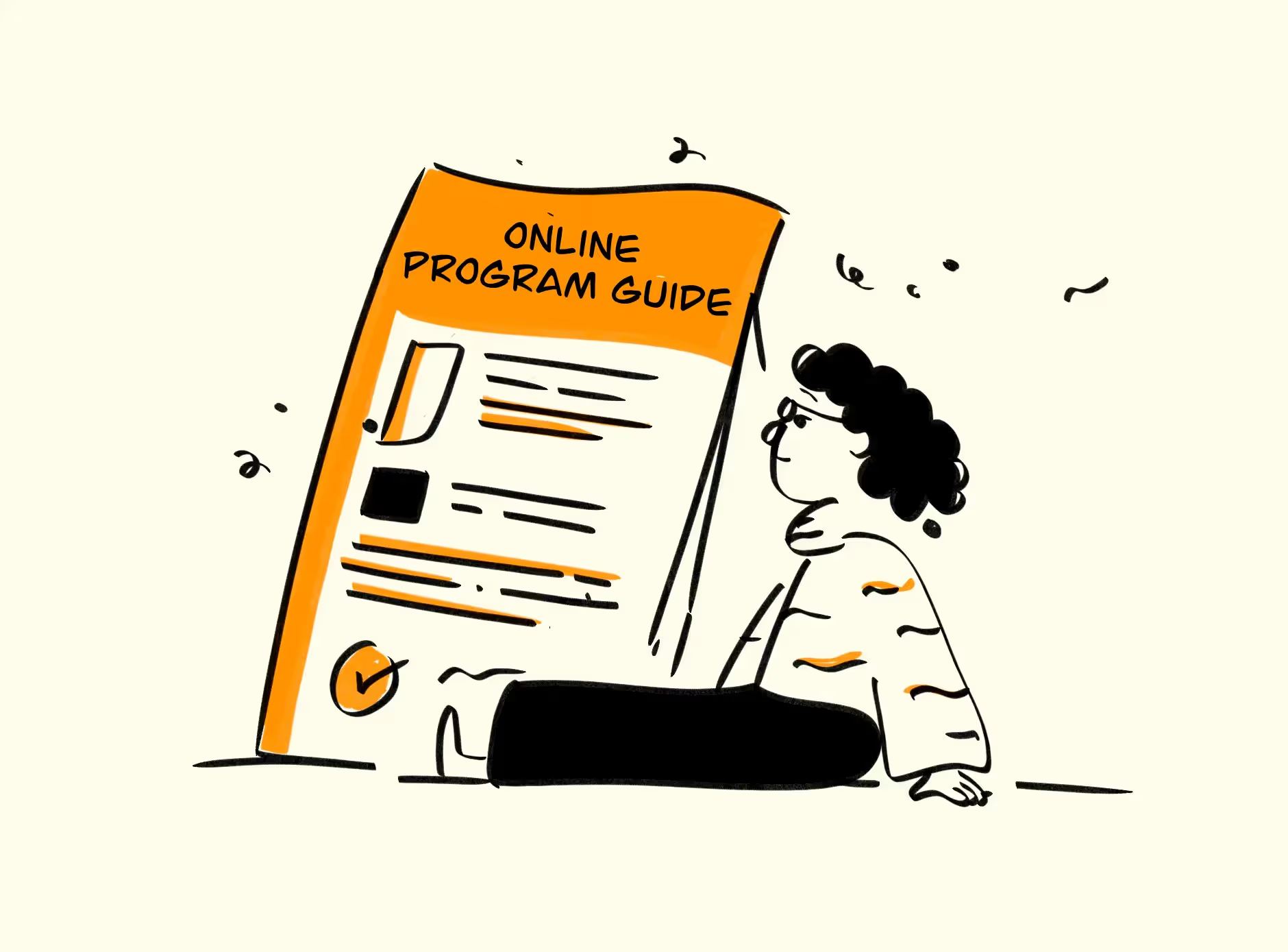![How to Attract Students to Online Courses [5 Tips]](https://cdn.prod.website-files.com/62f0b227e38c6d799afcd8ba/642a702f5fbce22072754ef6_5_Strategy_Engage_Online_Course_.avif)
![How to Attract Students to Online Courses [5 Tips]](https://cdn.prod.website-files.com/62d6876535c5c7559909754c/67c036910fbf3721b5778e27_Attendance_Zoom-min%201.png)

Key Takeaways
- Effective Course Marketing: The content emphasizes leveraging social media, influencer partnerships, and affiliate programs to boost visibility and attract more students to online courses.
- Importance of Platform Selection: Choosing the right course platform, like EdisonOS, is highlighted as crucial for delivering an engaging and accessible learning experience with advanced analytics and interactive features.
Creating an online course is a great way to share your expertise and generate passive income. However, it’s not enough to create an amazing course - you must also market it effectively to attract future students. Without a solid marketing strategy, your course may not reach its full potential, and you may struggle to get the number of students you need to succeed.
Marketing your online course is essential to ensure that it stands out from the sea of other courses available online. It would help if you found ways to reach your target audience and persuade them that your course is their best choice. Effective marketing lets you get your course in front of more potential students, increase your enrollment numbers, and grow your revenue.
This blog post will explore five effective strategies for getting more students to your online course. These include:
- Leverage social media
- Invest in the best online course platform possible
- Network with influencers
- Create an affiliate program
- Optimise your landing page
- Crafting Storyline with Course
- Creating Engaging Instructional Design
Using these strategies, you can increase your visibility and attract more students to your online course. Whether you’re just starting or you’ve been offering courses for years, these tips can help you take your business to the next level. So, let’s dive in and explore each strategy in more detail.
1. Leverage social media
Social media is a powerful tool for promoting your online course and reaching potential students. With billions of users worldwide, social media platforms like Facebook, Instagram, Twitter, and LinkedIn offer an incredible opportunity to connect with people and build an audience for your course.
To leverage social media effectively, you must create engaging content that resonates with your target audience. This could include posts that provide helpful tips and advice related to your course topic or showcase the benefits and outcomes of taking your course. You can also share success stories from students who have taken the course and highlight any special offers or discounts.
Here are some tips for leveraging social media to promote your online course:
- Identify your target audience
Before creating social media content, you need to understand who your ideal student is. Who are they, what do they need, and what problems can your course solve for them? Once you have a clear picture of your target audience, you can create content that speaks directly to their needs and interests.
- Choose the right platforms.
Not all social media platforms are created equal; you don’t need to be on every single one. Choose the most relevant platforms for your target audience, and focus your efforts there. For example, LinkedIn might be a better choice than Instagram if you target professionals in a particular industry.
- Create engaging content
Social media is all about engagement, so you must create content encouraging people to like, comment, and share. This could include posts that ask questions, share interesting statistics, or provide helpful tips and advice.
- Use targeted hashtags
Hashtags are a powerful way to reach new audiences on social media. Please research which hashtags are popular in your niche and use them in your posts to increase your visibility.
- Engage with your followers.
Social media is a two-way conversation, so don’t just post and run. Respond to comments and messages and engage with your followers personally. This will help you build relationships and loyalty and encourage more people to enrol in your course.
By leveraging social media effectively, you can reach more potential students and build a loyal audience for your online course. Don’t be afraid to experiment with different types of content and strategies, and track your results to see what’s working best for you.
Understanding Your Target Audience for Online Learning
Understanding your target audience is crucial for creating effective online learning experiences. Identifying your ideal student helps you tailor your course content, marketing strategies, and support services to meet their needs. When defining your target audience, consider age, location, occupation, interests, and learning goals.
Analyze your competitors’ target audiences to identify gaps in the market and opportunities to differentiate your online course. Use online analytics tools to gather data on your website visitors, social media followers, and email subscribers to gain insights into their behaviour and preferences. Conduct surveys, focus groups, or interviews to gather feedback from potential students and refine your understanding of their needs and expectations.
Create buyer personas representing your ideal students and guiding your marketing and course development efforts. Continuously monitor and update your understanding of your target audience as your online course evolves and grows. Knowing your target audience inside and out can create a more personalized and effective online learning experience that attracts and retains students.
2. Invest in the Best Online Course Platform Possible
When creating and delivering an online course, the online learning platform you use is just as important as the content you create. Investing in the best online course platform possible can make a significant difference in the success of your course. Here are some reasons why:
- Accessibility
A good online course platform should be accessible to all students, regardless of location, device, or internet speed. Look for a platform that supports various devices and internet speeds and offers easy-to-use tools for accessing the course content.
- Ease of navigation
Students should be able to navigate the course content easily and intuitively. The online course platform should be designed with a user-friendly interface so students can focus on learning, not figuring out how to use the platform.
- Engagement
The best online course platforms offer a range of interactive features to keep students engaged throughout the course. These could include video lectures, interactive quizzes, discussion forums, and personalised feedback.
- Analytics
The platform should also offer analytics tools that allow you to track student progress, identify areas where students may be struggling, and adjust the course content accordingly. This will help you improve the course and provide a better learning experience for your students.
- Customer support
Finally, a good online course platform should offer excellent customer support to help you and your students with technical issues or questions. Look for a platform that offers 24/7 support and a dedicated support team to ensure your course runs smoothly.
When researching online course platforms, consider pricing, features, ease of use, and customer support. Look for reviews and recommendations from other course creators, and try different platforms to find the one that best meets your needs.
Remember, your online course is only as good as the platform you use to deliver it. Investing in the best platform ensures that your course is accessible, engaging, and effective for your students.
3. Network with influencers
In today’s digital age, social media influencers are increasingly important in marketing and advertising. By partnering with influencers in your industry, you can reach a larger audience and gain credibility for your online course. Here are some tips for networking with influencers to promote your course:
- Identify relevant influencers
Start by identifying influencers in your industry or niche. Look for individuals who have a large following on social media platforms like Instagram, Twitter, and YouTube and who create content related to your course topic.
- Build relationships
Once you’ve identified potential influencers, start building relationships with them. Follow them on social media, comment on their posts, and engage with their content. Share their content with your followers and tag them in your posts.
- Reach out
Once you’ve built a relationship with influencers, contact them directly and propose a collaboration. Explain what your course is about and how it can benefit their followers. Offer them free course access or exclusive discounts in exchange for promotion on their social media channels.
- Provide value
When working with influencers, providing value to their followers is essential. Create engaging content, like a video or an infographic, that explains the benefits of your course. Offer a discount code or a free trial to incentivize their followers to enrol.
- Measure success
Keep track of how your collaboration with influencers is performing. Monitor engagement on their posts, track the number of clicks and conversions, and assess whether the partnership successfully drove new student enrollments.
Remember that building relationships with influencers takes time and effort. Be genuine in your interactions and focus on providing value rather than simply promoting your course. By working with influencers, you can expand your reach and attract new students to your online course.
4. Crafting Storyline with Course
A well-crafted course description is essential for attracting prospective students to your online course. Clearly state the course title, objectives, and outcomes to help students understand what they will learn and achieve. Highlight your course's unique benefits and features, such as interactive elements, real-world examples, or expert instructors.
Use persuasive language and storytelling techniques to engage potential students and convey the value of your course. Include relevant keywords and phrases to improve your course’s visibility in search engine results. Use social proof, such as student testimonials or reviews, to build credibility and trust with potential students.
Provide detailed course format, duration, and schedule information to help students plan and prepare. Offer a clear call-to-action, such as “Enroll Now” or “Learn More,” to encourage potential students to take the next step. A compelling course description can make all the difference in attracting and converting prospective students.
5. Create an Affiliate Program
Affiliate programs are a great way to promote your online course and increase student enrollment. To effectively recruit online students, focusing on visibility on search engines, building student support, and having a dedicated role in overseeing the student experience is essential. By offering affiliates a commission for each student they refer, you can leverage your affiliates’ networks to reach more relevant people and drive more sales.
When creating an affiliate program for your online course, there are a few things to consider. Here are some steps you can take to create an effective affiliate program:
- Set commission rates
Determine the commission rates you will offer to affiliates. This can be a flat fee per sale or a percentage of the sale. Consider what a fair commission would be that would motivate affiliates to promote your course.
- Choose an affiliate tracking system.
To run an affiliate program, you will need an affiliate tracking system. This system will track the sales made by your affiliates and calculate the commissions earned. Popular affiliate tracking systems include Clickbank, Commission Junction, and ShareASale.
- Create an affiliate page.
Create a dedicated page on your website explaining the details of your affiliate program. This page should include information about commission rates, payment methods, and instructions on how to sign up. Provide marketing materials such as banners, images, and copy that affiliates can use to promote your course.
- Recruit affiliates
Reach out to potential affiliates in your niche or industry. Look for bloggers, podcasters, or social media influencers with a following that aligns with your target audience. You can also advertise your affiliate program on your website, social media channels, or affiliate marketing forums.
- Train your affiliates
Provide your affiliates with resources and support to help them promote your course effectively. This can include access to your course or course materials, marketing tips, and strategies for engaging with their audience.
- Track and measure success
Monitor your affiliate program's performance regularly. Track the number of referrals, sales, and commissions your affiliates earn. Analyse the data to identify opportunities for improvement and optimise your program for maximum success.
Creating an affiliate program can be an effective way to promote your online course and increase enrollment. By setting commission rates, choosing an affiliate tracking system, creating an affiliate page, recruiting affiliates, training them, and tracking and measuring success, you can build a successful affiliate program that drives more sales and expands your reach.
6. Optimise Your Landing Page
Your landing page is the first point of contact between your course and potential students. Optimising your landing page to attract and convert visitors is essential to effectively sell online courses. Here are some tips to help you optimise your landing page for your online course:
- Use relevant keywords
Use relevant keywords in your page title, meta description, and headings to ensure your page is SEO-friendly. This will help your page rank higher in search engine results and attract more visitors.
- Create compelling copy
Use persuasive copy that clearly explains the benefits of your online course. Highlight your course's value to potential students and explain how it can help them achieve their goals. Use testimonials and success stories from previous students to add social proof and credibility to your course.
- Include a call-to-action
Include a clear and compelling call-to-action (CTA) on your landing page to encourage visitors to sign up for your course. Use action-oriented language such as “Enrol Now” or “Get Started” to encourage visitors to take action.
- Optimise for mobile devices
Ensure that your landing page is optimised for mobile devices. Most people browse the internet on their mobile devices, so it’s essential to ensure your landing page is easily accessible and readable on a smartphone or tablet.
- Keep it simple
Keep your landing page simple and easy to navigate. Avoid clutter and unnecessary elements that can distract visitors from your course’s key benefits and call to action.
- Test and refine
Test different landing page elements like copy, CTA, and design to see what works best. Use A/B testing to compare different landing page versions and refine it based on the results.
Optimising your landing page is crucial to attracting potential students and converting them into paying customers. By using relevant keywords, creating compelling copy, including a clear call-to-action, optimising for mobile devices, keeping it simple, and testing and refining your landing page, you can build an effective and persuasive landing page for your online course.
Promoting an online course is essential in connecting with potential students and increasing visibility and engagement. Using a combination of digital marketing strategies, you can reach a wide range of potential students, build a robust online presence, and create a successful learning platform. Taking the time to promote an online course properly can make all the difference in the success of the course and is a critical part of the online education industry.
7. Creating Engaging Instructional Design
Engaging course content is critical for keeping students motivated and invested in your online course. Use a variety of content formats, such as videos, images, podcasts, and text-based materials, to cater to different learning styles. Incorporate interactive elements, such as quizzes, discussions, and gamification, to promote active learning and participation.
Use real-world examples and case studies to illustrate key concepts and make the course more relatable and applicable. Provide opportunities for students to practice and apply what they have learned through assignments, projects, or simulations. Use storytelling techniques and anecdotes to make the course more engaging and memorable.
To gather feedback and improve the course, incorporate feedback mechanisms, such as surveys or discussion forums. Continuously update and refresh the course content to keep it relevant and up-to-date. Creating engaging course content can enhance the learning experience and increase student satisfaction and retention.
How to Use EdisonOS for Attracting Students to Your Online Courses
Attracting students to your online courses is crucial for the success of your educational business. EdisonOS provides a range of features and tools that can help you effectively market your courses and engage potential students. Here’s how you can leverage EdisonOS to attract more students to your online offerings:
1. Showcase Course Previews and Free Trials
EdisonOS allows you to offer course previews and free trials, giving potential students a taste of what they can expect from your full course. By providing a sneak peek into the course content, you can build trust and demonstrate the value of your course, which can significantly increase enrollment rates. This approach is particularly effective among undergraduate students, increasingly enrolling in online courses as a legitimate alternative to traditional education.
2. Optimize Your Course Pages for Search Engines
With SEO-friendly course pages, EdisonOS enables you to optimize your content for search engines. You can improve your visibility on search engines like Google by incorporating relevant keywords in your course titles, descriptions, and meta tags. This makes it easier for prospective students to find your courses when they search for related topics.
3. Utilize Email Marketing Campaigns
EdisonOS supports automated email marketing campaigns, allowing you to reach potential students with personalized messages. You can set up email sequences to nurture leads, share course updates, and highlight unique features of your courses. This continuous engagement helps keep your courses top-of-mind for prospective students, increasing the likelihood of conversion.
4. Build Funnels and Landing Pages
EdisonOS offers tools to create effective sales funnels and dedicated landing pages that guide potential students through decision-making. With the rise of online teaching, adapting to the evolving educational landscape is crucial. By designing targeted landing pages highlighting your courses’ key benefits and integrating them into a well-structured funnel, you can lead prospective students from initial interest to final enrollment. Use clear calls-to-action, compelling visuals, and testimonials on your landing pages to boost conversions and make enrollment seamless. This strategic approach helps convert more visitors into enrolled students, ensuring that your marketing efforts yield the best possible results.
6. Host Live Webinars and Interactive Sessions
EdisonOS’s integration with live webinars and Q&A sessions offers a great way to engage with potential students. Hosting live sessions where you can answer questions and demonstrate your teaching style can create a direct connection with prospective students, increasing their interest in your courses.
7. Build a Community Around Your Courses
Creating a sense of community can be a major draw for students who value peer learning and interaction. EdisonOS includes forums and group chat features that allow you to build a supportive community around your courses. Promoting this community aspect can attract students looking for a more collaborative learning experience.
8. Offer Special Promotions and Discounts
Using EdisonOS, you can create and manage special promotions, such as early-bird discounts or bundle offers. Limited-time promotions can create a sense of urgency and encourage students to enrol sooner rather than later. Advertise these offers across your marketing channels to maximize their impact.
If you're looking for the best online course platform, look no further than EdisonOS! Our platform offers the most comprehensive and intuitive learning experience for students and instructors alike. With our easy-to-use tools, you can create engaging and interactive courses quickly. Sign up today and start creating the course of your dreams!
Providing Excellent Customer Support and Incentives
Providing excellent customer support is essential for building trust and loyalty with your online students. To cater to different preferences and needs, offer multiple support channels, such as email, phone, or live chat. Respond promptly to student inquiries and concerns and provide clear and concise solutions.
Offer incentives, such as discounts, free trials, or exclusive content, to attract new students and reward loyal customers. Use personalized communication and marketing strategies to build student relationships and promote your online course. Provide opportunities for students to connect with instructors through discussion forums, social media groups, or live events.
Offer recognition and rewards for student achievements, such as certificates, badges, or leaderboard rankings. Continuously gather feedback and improve your customer support and incentive strategies to meet the evolving needs of your online students. Excellent customer support and attractive incentives can significantly enhance the student experience and drive enrollment.
Measuring and Optimizing Performance
Measuring and optimizing performance is critical for ensuring the success and growth of your online course. Use analytics tools to track key metrics, such as enrollment rates, completion rates, and student engagement. Monitor student feedback and reviews to identify areas for improvement and optimize the course content and support services.
Regular assessments and evaluations should be conducted to measure student learning outcomes and program effectiveness. Use data-driven insights to inform marketing and recruitment strategies and to identify opportunities to expand and diversify your online course offerings. Continuously update and refine your online course to reflect market, industry, or student needs changes.
Use benchmarking and best practices to compare your online course with others in the industry and identify areas for improvement. Celebrate successes and achievements, and use them to promote your online course and attract new students. By measuring and optimizing performance, you can ensure that your online course remains competitive and effective in meeting the needs of your students.
Conclusion
Promoting an online course is essential in connecting with potential students and increasing visibility and engagement. Using a combination of digital marketing strategies, you can reach a wide range of potential students, build a robust online presence, and create a successful learning platform. Taking the time to promote an online course properly can make all the difference in the success of the course and is a critical part of the online education industry.
If you're looking for the best online course platform, look no further than EdisonOS! Our platform offers the most comprehensive and intuitive learning experience for students and instructors alike. With our easy-to-use tools, you can create engaging and interactive courses in no time. Sign up today and start creating the course of your dreams!

Recommended Reads
Recommended Reads











.png)
.webp)
